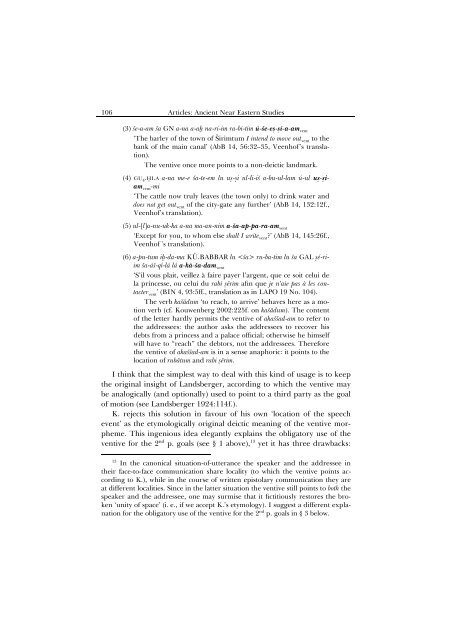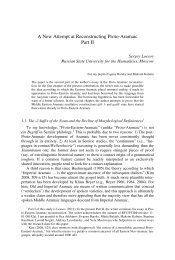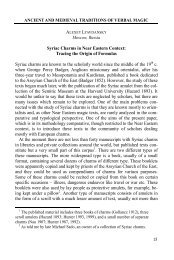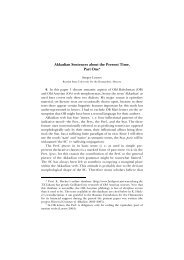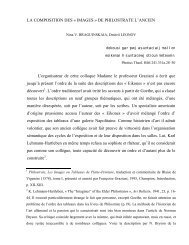Marginalia on the Akkadian Ventive*
Marginalia on the Akkadian Ventive*
Marginalia on the Akkadian Ventive*
You also want an ePaper? Increase the reach of your titles
YUMPU automatically turns print PDFs into web optimized ePapers that Google loves.
106 Articles: Ancient Near Eastern Studies<br />
(3) še-a-am ša GN a-na a-a na-ri-im ra-bi-tim ú-še-e´-´í-a-am vent<br />
‘The barley of <strong>the</strong> town of Širimtum I intend to move out vent to <strong>the</strong><br />
bank of <strong>the</strong> main canal’ (AbB 14, 56:32–35, Veenhof ’s translati<strong>on</strong>).<br />
The ventive <strong>on</strong>ce more points to a n<strong>on</strong>-deictic landmark.<br />
(4) GU 4.ÚI.A a-na me-e ša-te-em lu u´-´i ul-li-iš a-bu-ul-lam ú-ul u´-´iam<br />
vent-mi<br />
‘The cattle now truly leaves (<strong>the</strong> town <strong>on</strong>ly) to drink water and<br />
does not get out vent of <strong>the</strong> city-gate any fur<strong>the</strong>r’ (AbB 14, 132:12f.,<br />
Veenhof’s translati<strong>on</strong>).<br />
(5) ul-[l]a-nu-uk-ka a-na ma-an-nim a-ša-ap-pa-ra-am vent<br />
‘Except for you, to whom else shall I write vent?’ (AbB 14, 145:26f.,<br />
Veenhof ’s translati<strong>on</strong>).<br />
(6) a-pu-tum i-da-ma KÙ.BABBAR lu ru-ba-tim lu ša GAL ´é-riim<br />
ša-áš-qí-lá lá a-kà-ša-dam vent<br />
‘S’il vous plait, veillez à faire payer l’argent, que ce soit celui de<br />
la princesse, ou celui du rabi ´ērim afin que je n’aie pas à les c<strong>on</strong>tacter<br />
vent’ (BIN 4, 93:5ff., translati<strong>on</strong> as in LAPO 19 No. 104).<br />
The verb kašādum ‘to reach, to arrive’ behaves here as a moti<strong>on</strong><br />
verb (cf. Kouwenberg 2002:225f. <strong>on</strong> kašādum). The c<strong>on</strong>tent<br />
of <strong>the</strong> letter hardly permits <strong>the</strong> ventive of akaššad-am to refer to<br />
<strong>the</strong> addressees: <strong>the</strong> author asks <strong>the</strong> addressees to recover his<br />
debts from a princess and a palace official; o<strong>the</strong>rwise he himself<br />
will have to “reach” <strong>the</strong> debtors, not <strong>the</strong> addressees. Therefore<br />
<strong>the</strong> ventive of akaššad-am is in a sense anaphoric: it points to <strong>the</strong><br />
locati<strong>on</strong> of rubātum and rabi ´ērim.<br />
I think that <strong>the</strong> simplest way to deal with this kind of usage is to keep<br />
<strong>the</strong> original insight of Landsberger, according to which <strong>the</strong> ventive may<br />
be analogically (and opti<strong>on</strong>ally) used to point to a third party as <strong>the</strong> goal<br />
of moti<strong>on</strong> (see Landsberger 1924:114f.).<br />
K. rejects this soluti<strong>on</strong> in favour of his own ‘locati<strong>on</strong> of <strong>the</strong> speech<br />
event’ as <strong>the</strong> etymologically original deictic meaning of <strong>the</strong> ventive morpheme.<br />
This ingenious idea elegantly explains <strong>the</strong> obligatory use of <strong>the</strong><br />
ventive for <strong>the</strong> 2 nd p. goals (see § 1 above), 13 yet it has three drawbacks:<br />
13 In <strong>the</strong> can<strong>on</strong>ical situati<strong>on</strong>-of-utterance <strong>the</strong> speaker and <strong>the</strong> addressee in<br />
<strong>the</strong>ir face-to-face communicati<strong>on</strong> share locality (to which <strong>the</strong> ventive points according<br />
to K.), while in <strong>the</strong> course of written epistolary communicati<strong>on</strong> <strong>the</strong>y are<br />
at different localities. Since in <strong>the</strong> latter situati<strong>on</strong> <strong>the</strong> ventive still points to both <strong>the</strong><br />
speaker and <strong>the</strong> addressee, <strong>on</strong>e may surmise that it fictitiously restores <strong>the</strong> broken<br />
‘unity of space’ (i. e., if we accept K.’s etymology). I suggest a different explanati<strong>on</strong><br />
for <strong>the</strong> obligatory use of <strong>the</strong> ventive for <strong>the</strong> 2 nd p. goals in § 3 below.


